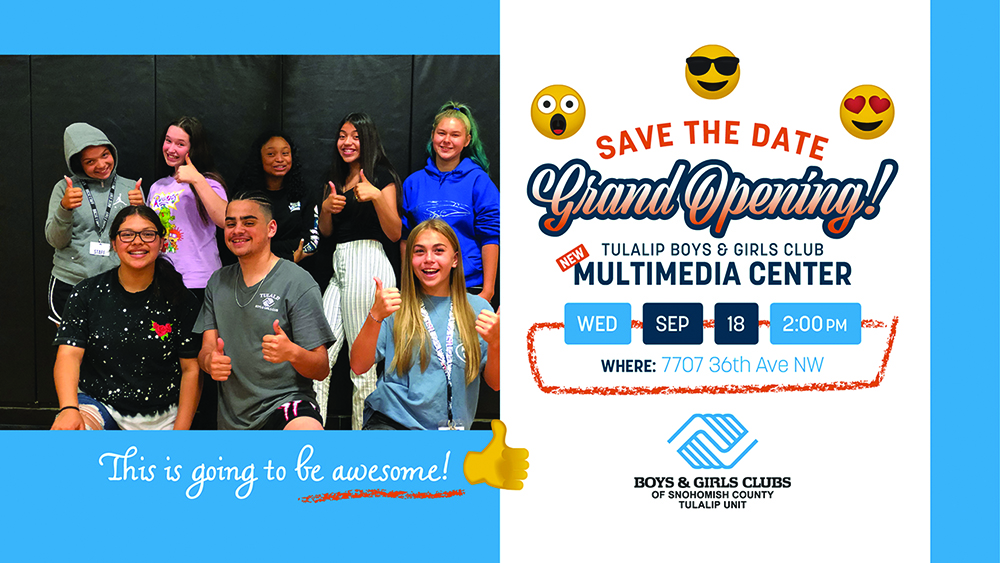
Tulalip Tribes Financial Meeting, Oct 17

syəcəb

The sale and use of illicit drugs is an epidemic, not only on the Tulalip Reservation, but across the nation. The Tulalip Police Department is committed to halting the sale of drugs on our reservation.
On Thursday August 15, 2019, detectives of the Tulalip Tribal Police Drug Task Force, assisted by uniformed patrol officers, executed a search warrant on a residence in the Y-Site neighborhood of the Tulalip Reservation. This search warrant comes after a month-long investigation into the sale and distribution of illegal drugs from this residence. One suspect is in custody at this time.
This latest arrest is part of the ongoing effort by Tulalip Tribal Police to address drug dealing on the Tulalip Reservation and specifically in tribal housing. We understand that for families in our community, no criminal investigation can happen quickly enough. We want to assure you that although you may not always see our progress, we are actively working to stop the sale of drugs on our reservation. That means being meticulous in our investigations, so that convictions result from arrests. All of these efforts take time.
The best way to help us put dealers out of business for good is when you see something, say something. If you see suspicious activity, call our tip-line, 360-716-5990, and help us build a better Tulalip.

By Liz Brazile, Crosscut; photos by Micheal Rios
About a dozen Seattle-area youth gathered at Bitter Lake Community Center on a recent Saturday afternoon for a day of studying the journalistic process. The students, ages 12 to 18, have spent part of their summer break learning what it means to produce news in a digital era, during a time of significant change in how people consume media.
During the session, they learn about the intersections of mainstream and tribal news media.
“How does this look different from a regular newspaper like The Seattle Times?” asks journalist Micheal Rios, holding up a recently published issue of the Tulalip Syeceb newspaper. The students take notice of the front page’s text, which isn’t in English.
“So this is Lushootseed, the traditional language of Tulalips,” Rios says. “Some would say its Northern Lushootseed,” he continues, heard in “the Coast Salish area that runs from about Nisqually to Vancouver, B.C. It’s a shared language.”
Now serving its second cohort, this multiday teen journalism workshop is hosted by the Urban Native Education Alliance as an extension of its Clear Sky Native Youth Council program. Participating students represent a number of tribes, including the Muckleshoot, Lakota, Arapaho and Yakama.
The two-week series is aimed at increasing news media literacy and imparting journalistic skills to a rising generation of Native American storytellers.
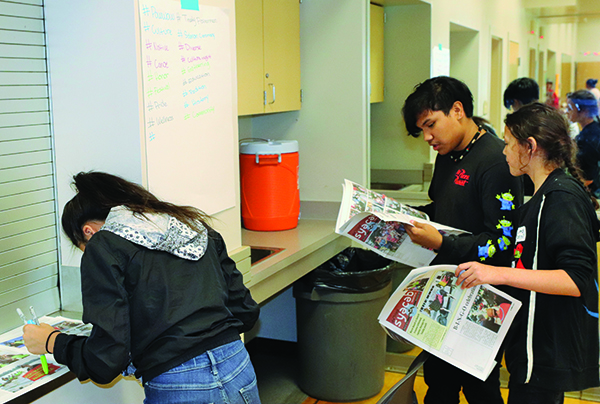
Washington’s Office of Superintendent of Public Instruction convened a task force in 2016 to advise school districts on how to integrate media literacy and digital citizenship teachings into curricula. Several Puget Sound schools, including those in Seattle, Kent, Auburn and Edmonds, have implemented such lessons to varying degrees.
But mentors with Clear Sky are hoping to take this kind of education a step further. Their goal, in part, is to prepare students to amplify underrepresented Native voices and communities.
“We’re hoping they walk away with better reading and writing skills … as well as some knowledge on how you can use media to help your community,” says A.J. Oguara, Clear Sky program coordinator and former student. “Even if [an activity] helps them interpret an existing idea that they’re already kind of familiar with, to understand it better, it’s pretty valuable.”
Beginning in 2016, a group of researchers and advocates with the Reclaiming Native Truth Project at the First Nations Development Institute set out to uncover the impact of negative portrayals of Indigenous people in the media.
Among the team’s findings were that the voices of present-day Native peoples are overwhelmingly missing in school curricula, news media, pop culture entertainment and the legal system. That absence, according to a 2018 report, has contributed to a general lack of understanding of and attention given to Native issues, as well as misconceptions about the Native population shrinking.
Participants in Clear Sky’s journalism workshop don’t shy away from tough subjects. The epidemic of missing and murdered Indigenous women in North America and the effects of gun violence on Native communities are some of themes in multimedia stories the students are developing.
“I think this is really important,” 12-year-old Chante Remle, a student at Edmonds Heights K-12, says of the workshop. “To spread, you know, awareness [about] the things people don’t really care too much about.”
Taleah Vaomu, 17, doesn’t necessarily aspire to have a career in journalism; she sees going into youth counseling as a better fit. But what she’s learned at the workshop has been no less beneficial, she says.
“It does help me out with school and everything,” says Vaomu, soon to be a senior at the Muckleshoot Tribal School in Auburn. “There’s a lot of things I could take in that I wouldn’t really know until later on in school. So … if I go back into school, I can be like, ‘Oh, I know this, or know this’ and things like that.”
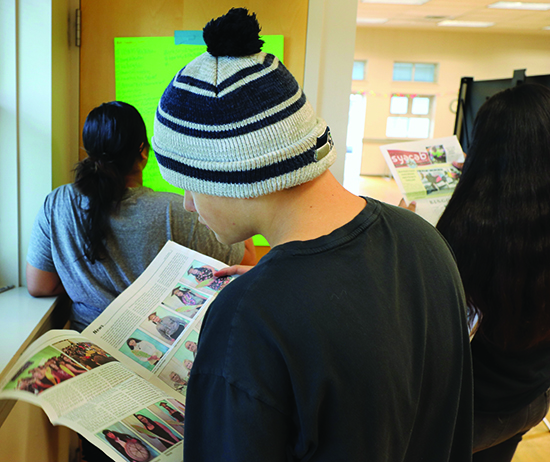
Before the youth complete their own, collaborative stories, they go through a crash course on journalism ethics and principles: what does it mean to present information fairly, how do you separate fact from fiction and how do you approach difficult subject matter in your reporting?
A 2015 study in the Journal of Media Literacy Education suggests that adolescents who demonstrate higher news literacy — marked in part by a keen understanding of current events and a greater scrutiny of news sources — tend to be more selective and proactive about the news they consume. That is to say, they are better able to filter news in a useful way.
The days of readers flipping through broadsheets and tabloids are dwindling. Young people, like the workshop students, are overwhelmingly getting their news from nontraditional platforms such as Instagram, YouTube and Snapchat.
“You can find out information about people in places you’ve never been to, you might never go to,” Rios tells them. “But you’re able to access that information like never before.”
But with that boundless access to information comes a greater responsibility for separating fact from fiction, he points out.
“There’s a lot of blurred lines between what is news and what is not news,” Rios says, asserting how quickly false news stories can pick up steam on social media.
A key element of the workshop is teaching students how to discern the veracity and bias of the content they engage. They also learn interviewing techniques and how to compile research from literary sources.
Upon successful completion of the workshop, which is sustained through grants from King County and the Discuren Charitable Foundation, the participants will receive a $500 stipend.
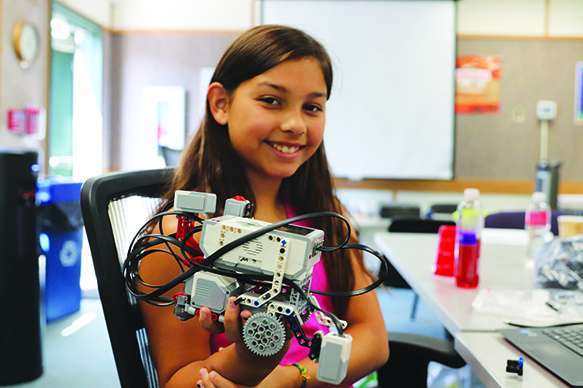
By Kalvin Valdillez, Tulalip News
“Technology is the key to the future,” said Matthew Collier, Certified LEGO Robotics Instructor and Co-founder of Robotic.How.com. “If you look at your hand, you’re the only one with that hand, those fingerprints. You were born to leave your fingerprint somewhere. And if we can teach you, help you find what you’re supposed to put your hand on and leave your print, then you’re going to be more motivated, you’re going to have a purpose in life. We can teach these kids a purpose in STEM, it’s important because that’s the future.”
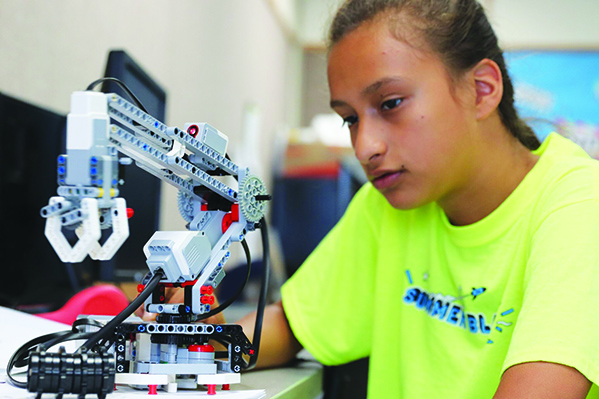
For the fourth year in a row, Matthew and his wife Kathy brought a week’s worth of Science, Technology, Engineering and Math fun to the summer school students of the Tulalip Tutoring and Homework Support program. Known by the local kids as ‘robot camp’, the Colliers teach students going into grades kindergarten through twelfth, basic computer coding, programming and design by building robots with LEGOS.
The students split into three groups based on which grade they will be entering at the beginning of the school year; kindergarten through second grade; third through fifth grade; and sixth through twelfth grade.
“Kindergarten through second graders are doing science experiments using the LEGO WeDo robots,” explains Kathy. “They are doing simple coding; they can actually explain to you the function of each LEGO piece. The third through fifth graders are using the EV3 Robots, which is actually being used by first year college students at MIT. And the sixth through twelfth grades are programing their robots to make a directional decision at each turn.”
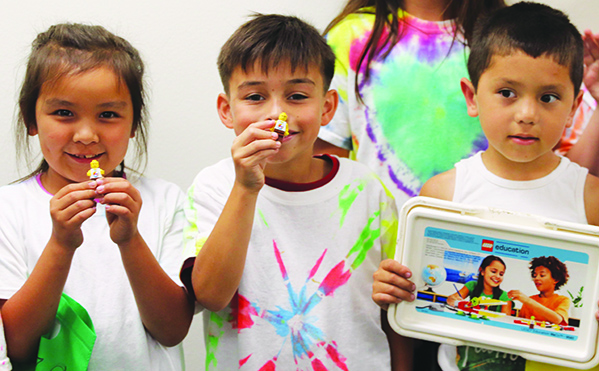
The youngest group programed a number of LEGO robots to drum, dance, and roar throughout the week, building alligators, lions, monkeys and airplanes. The third through fifth grade students worked on an EV3 rolling robot during STEM week, coding it to move throughout the classroom. The older kids were challenged to create a robot that can move without wheels.
Young Catherine Velazquez focused intently on completing her challenge, continuing to work on her bot during the free time portion of the day. Catherine was onto something as she gave her bot two long LEGO pieces as legs and used trial and error until her robot was walking through an obstacle course in the classroom.
“It’s fun and pretty easy once you get into it,” Catherine proudly exclaimed. “I liked messing with it, programming it to walk and make turns. I liked making my robot move forward and backwards and it can use its sensors to detect when its centimeters away from hitting something, so I programmed it to make a turn when it gets close to anything. I’ve had lots of fun here at robotics camp.”
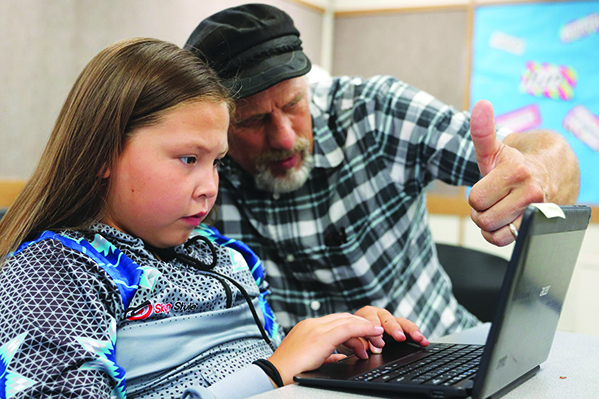
Matthew and Kathy added a new programming software for their elementary students to explore this year. The kids had a blast using Scratch, a visual program which teaches them how to use JavaScript to remix a number of online games, video clips, music and sound bites into one project.
“Today I uploaded this narwhal music video to my project and I’m listening to it,” said STEM Robotics camper, Mason Jefferson. “I’ve never done anything like this before, it’s all new to me. I’m learning a lot, how to program robots and remix projects on Scratch.”
Along with learning how to code videos and program robots, the kids also explore a variety of scientific principles by conducting a series of experiments as well as constructing telescopes and making tie-dye t-shirts. With wide smiles on full display, the kids happily soaked up knowledge from each lesson and were eager to continue learning each day.

“I believe when a child is given the opportunity, support and encouragement, they will travel as far as they can go, we always tell them to reach for the stars,” expressed Margarita Huston, Tutoring and Homework Support Program Instructor. “We had two particular students who were able to reprogram their computers, so they did more with them when they were building their robots than the actual instructions required.
“We have one student who has been given a label by the schools as a troublemaker. He was one of the two to reprogram his computer. He was so focused. There was no trouble, no reacting in a negative manner; he was ready to come in and learn. In fact, he was impatient to get started every morning. He told me, ‘here I’m not dumb’.”
After four successful years teaching at Tulalip, the couple plans on expanding their program to reach an older demographic. Although the amount of participation has seen an overall increase over the years, more young kids attend the camp than high school students. Matthew explained that he understands that the high school age group has a much busier summer schedule than the little ones, but he intends to draw the older kids in by hosting a Unity camp during the summer of 2020. Unity is a licensed game engine used by amateur designers and professional software developers alike to build video games.
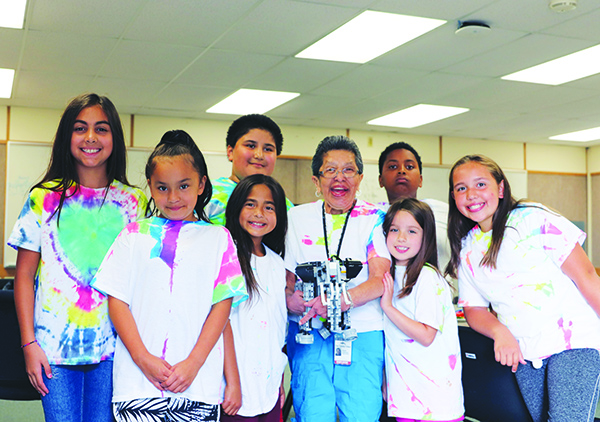
“Next year we want to come in with solid stepping-stones for these kiddos,” says Matthew. “We want to keep building that excitement. There’s a new robot kit coming out so we’re going to be upgrading all the different robots we’re working with. We’re also reaching out to the older kids, incorporating more tech and design by teaching them the Unity program. Unity is what a lot of the big games are made with. As educators, we can get it and teach the kids how to build their own games. You can make hundreds of thousands of dollars a year if you know how to program in unity.
“I guarantee in the next twenty, thirty years there will be autonomous cars everywhere because they’re safer,” Matthew continued. “That is going to affect everybody, no matter where you live or what country you’re in, it’s going to change the face of communities everywhere. We need these kids to have that information embedded in their DNA or else they’re going to be lost. We want to plant a bunch of stuff in front of them and say, look what you can do.”
Margarita stated that because of STEM Robotics Week’s popularity and success, the Tutoring and Homework Support Program looks forward to a ‘bright’ future with Colliers.
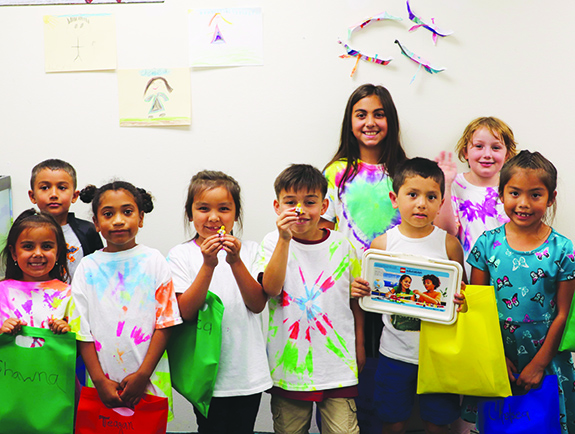
After saying goodbye to all her summer school friends and making sure to hug all of the instructors, STEM student, Tashina Cortez, fondly shared what she learned after attending her fourth robotics camp with the summer school.
“At robotics camp we learn how to program and build robots,” she explained. “I built a robot that could move, dance, do the moonwalk and speak. It was really cool making it speak; it can also do mazes and turns. I learned that people can make robots that can help people with disabilities. When I’m older, I might become an engineer and maybe invent something that will help people with their disabilities.”
For additional details please contact the Tulalip Tutoring and Homework Support Program at (360) 716-4646.
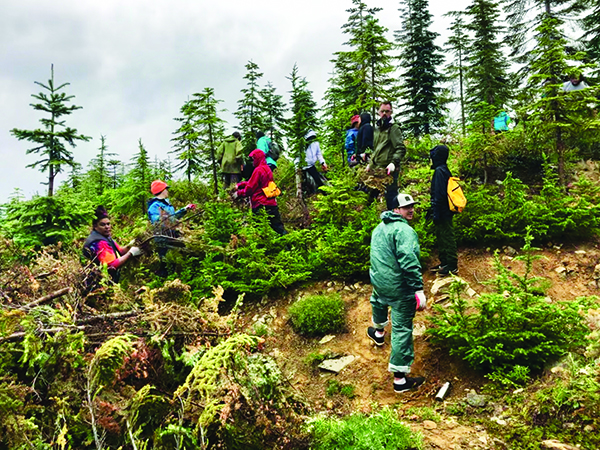
By Kalvin Valdillez; Photos courtesy of Kelly Finley, Michael Lotan, Ross Fryberg, and Tawnya Baggerly
“You would think it’s just another camp but when you get up there, you realize it’s so much more. You experience living how our ancestors used to; no phones and no technology at all. It was nice to get away, I had a really fun time,” expressed Tulalip tribal youth, Ross Fryberg Jr.
With an abundance of breathtaking views of the natural world, the mountainous lands near the Skykomish Watershed area was once home to the Snohomish people who lived upon its plentiful resources since the beginning of time. As the original caretakers, the connection they shared with the land was strong. For generations, the Snohomish gathered cedar from the tall trees on the mountain side to weave a number of every day tools such as baskets and hats. They gathered a variety of plants for both medicinal purposes and nourishment, hunted elk, and fished in nearby rivers and streams, and most importantly, they cared for the land, honoring the living spirit of the mountains, waterways and trees.
Although times have changed and we now live in a fast-paced, technology based society, the Tulalips, as descendants of the Snohomish, maintain that relationship to their pre-colonial homelands. They perform spiritual work like harvesting huckleberries and cedar, as well as hunting and fishing just as their people had generations prior.
Five years ago, the Tulalip Natural Resources Department, in partnership with the YMCA, debuted Mountain Camp for the youth of the community, offering a chance to get away from the busy world, unplug and enjoy the great outdoors. Since its inception, Mountain Camp has provided an opportunity for Tulalip youth to get in touch with the Tribes’ origins and gain a new perspective about Mother Earth, learning of the many ways she provides for Northwest tribal people. Mountain Camp was such a success, it inspired Fish Camp, a similar summertime experience that takes place on Lopez Island and teaches youth about marine life and the Salish Sea.

Nine kids, ages 11-13, set out for a five-day adventure to the mountains on the morning of August 5. Meeting at the Tulalip Administration building, they received a weaving lesson from Anita (Keeta) and Jamie Sheldon. The kids assembled a number of baskets, and also bracelets and anklets, before the trip, while Lushootseed Teacher Maria Martin shared traditional stories.
This year, the Natural Resources department added Tulalip youth and Mountain Camp Alum, Seth Montero, to the crew. After showing an incredible amount of interest in natural resources, Seth returned to camp to continue learning from the natural environment and pass his teachings down to his younger peers.
“We’ve been trying to work on a program for kids who have aged out and still want to participate in the program,” said Tulalip Natural Resources Outreach & Education Coordinator, Kelly Finley. “Seth went to YMCA camp earlier this summer and learned how they do things at their camps. He picked up a lot of leadership skills so that he could come to our camp this year and be a leader-in-training, and hopefully one day a future counselor.”
The campers loaded onto the YMCA bus and officially set course to Skykomish, Washington, a two-hour road trip along Highway 2. After reaching their destination, the campers strapped on their backpacks and made a mile-and-a-half hike to Barclay Lake where they set up camp for the first few days. During this time, the kids enjoyed the sunny weather by swimming and fishing at the lake as well as identifying a variety of plants and bugs. To get a little shade from the heat, the campers went out into the woods and played Prometheus, a fun version of the capture the flag game, where the players objective is to steal their opponents’ flag without being seen.
After three nights at the lake, the campers hiked back to the YMCA bus and traveled up the mountain to about 5,000 feet above sea level. The kids set up camp here, at the sacred swədaʔx̌ali grounds, where tribal members gather huckleberries during the late summer months. The campers were joined by Natural Resources Senior Environmental Policy Analyst, Libby Nelson as well as Lushootseed Language Teacher, Michelle Myles. Libby provided a fun interactive lesson about the plants of the swədaʔx̌ali area, while Michelle shared stories in Lushootseed and worked on traditional introductions with the kids. Libby explained that during past camps the weather was clear at night and you could stargaze and see meteor showers. This year, however, the fog rolled in as Michelle shared traditional stories, providing a cool, yet somewhat eerie, setting.
Before calling it a night, the youth gathered enough huckleberries for pancakes the next morning as they were expecting a number of guests from the Tribe, Natural Resources, the Rediscovery Program and the Mt. Baker-Snoqualmie Forest department bright and early.
Upon awakening, the kids enjoyed food and company with their many guests before heading to the huckleberry fields to help out with the restoration of the swədaʔx̌ali area.
“The first work was kicked off five years ago by the first Mountain Camp youth,” said Libby. “And we also have Forestry do a lot of work here in September as well. Ross [Fenton] came up from Forestry and led the kids in clearing out some of the area. That’s been our goal, to keep the berries from being shaded out by conifer trees. That keeps the berry patches open, encourages new growth and makes it nicer for Tulalip berry pickers. Since last year, we put up new signs that talk about the elder’s teachings about huckleberries. We had each kid read one of the teachings of the elders and we talked about it a little bit.”
The crew headed back to the campsite where they wove cedar headbands with Tulalip tribal member, Chelsea Craig, and listened to their guests speak about the importance of preserving the resources of the land for future generations.

“The goal is to go up there and talk to the kids about natural resources, talk about why it’s important for Tulalip tribal members specifically to work in the natural resources field, what it means to us spiritually and culturally,” explained Ryan Miller, Tulalip Natural Resources Environmental Liaison. “We try to get them excited about that and get them to have some ownership of it. We tend to bring them up there and teach them as much as we can about the huckleberry restoration and let them know that we pass this on to you, it’s your job to continue to pass this on to the next generation and make sure these resources are here for them as well.
“I forget every year how amazing it is up there,” he continued. “I’m surprised every time I go back, just by the utter beauty of the site. There’s nothing but mountains and clouds around you, you only hear the sounds of nature. These kids have the opportunity to go out there and experience something that is much closer to what our ancestors experienced for thousands of years. It’s almost like you can feel the connection to the earth a lot stronger there.”
The campers spent the remainder of their time playing games and picking berries at the swədaʔx̌ali site. Many of the campers had yet to enjoy the tasty berries grown at high altitude, but according to lead camp counselor Michael Lotan, once their taste buds got a hold of the delicious ancestral snack, they couldn’t get enough.
“A lot of people told the kids they needed to eat the berries to feed their inner Indian,” Michael stated. “So, that’s all they did after that, was roam around looking for ripe berries and eating them. All of them want to go back up and pick more when the berries are ready in a couple of weeks. That’s another good thing this camp does, is show them we have this area that needs to be used otherwise we’ll lose our rights to use it.”
On their last day in the mountains, the youth packed up camp and headed to the river. Ending Mountain Camp with an extreme splash, the kids rafted down the Skykomish River before heading back to Tulalip for a welcome home celebration with their family and new friends.
“I really connected with the land because my ancestors were once there,” expressed first time Mountain Camper, Matthew Hunter. “We picked huckleberries and I even got to bring some home for my mom. The restoration was fun; we cleared some trees out and made a big pile so they can burn them later. It’s important that we grow more berries. This was my first time camping up there and I learned how to weave cedar, harvest huckleberries and connect with the land, campers and counselors. It was totally new experience for me and really fun.”
For more information, please contact the Tulalip Tribes Natural Resources Department at (360) 716-4617.
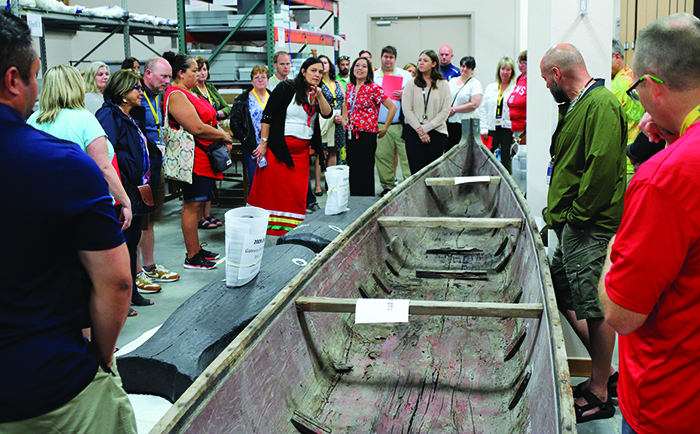
By Micheal Rios, Tulalip News
Imagine having just a single solitary day to impart generations’ worth of Tulalip cultural knowledge, experiences and insight onto a group of seasoned (non-Native) educators. It’s a near impossible task, to say the least. However, the noble pursuit of such a cultural exchange is significant for the glimmer of hope it may offer to deepen understanding of a complex history and thriving culture of a modern day Pacific Northwest tribe. Educators involved would gain tremendously by broadening their perspective on Tulalip related issues, while deliberately resulting in an improved learning environment for their Native students.
On August 8, fifty-three Marysville School District (MSD) administrators, including every principal and assistant principal in the District, convened at a Marysville-Getchell High School meeting space for what would be an enriching journey into ‘Tulalip 101’.
“I thank each and every one of you for this opportunity to share a part of our culture with you. We know the time frame is small, but it is significant,” said Deborah Parker, Indigenous Education Director. “The leaders of MSD have allowed us this time and space to share with you a piece of our culture, a piece of who we are and what we care about traditionally, mentally, emotionally, and physically.”
The Women’s Warriors Song was shared to ground the group with a singular purpose and align the heartbeats for a collective mission…one heart, one mind. What followed as a brief PowerPoint presentation on Tulalip Tribes history, Coast Salish culture, and a lesson on the importance of conducting land acknowledgements in each school.
“By doing land recognition we honor the sacrifices our ancestors made and make a commitment for true healing of the injustice that has been served in the name of education for Indigenous people,” explained Chelsea Craig, Cultural Specialist for Quil Ceda Elementary. “You have to add that second piece and really understand your value and how your equity statement goes with it – thanks for acknowledging that we lost our lands and this is what we’re committed to doing to promote healing.”
Land acknowledgment by itself is a small gesture. It becomes meaningful when coupled with authentic relationship and informed action. But this beginning can be an opening to greater public consciousness of Native sovereignty and cultural rights, a step toward balanced partnerships and understanding. Considering there are an estimated 1,200 Native students attending MSD schools, the importance of conducting land acknowledgements at school functions, like general assemblies or sporting events, can significantly raise mindfulness while promoting healing.
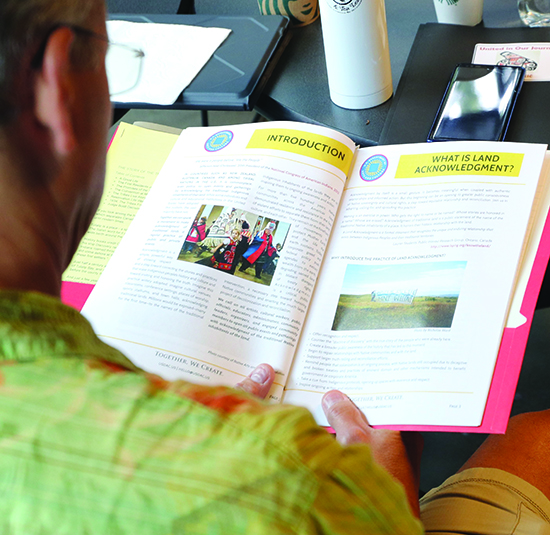
The fifty-three person group of MSD administrators learned two words in the ancestral Tulalip language of Lushootseed prior to a collaborative Tulalip tour – sduhubš (Snohomish) and τ̕igwicid (thank you). With both Deborah and Chelsea assisting in proper pronunciation, the group repeated the words several times in unison to ensure they would be properly used later in the day.
The collective group was split into two and shuttled to the Tulalip Reservation via MSD No.25 school busses. Their first visit was to Hibulb Cultural Center & Natural History Preserve where they enjoyed fresh made nettle lemonade and met with senior curator Tessa Campbell. As they were led on a private tour of Hibulb’s special collections, Tessa explained the special meaning and traditional use of several thought-provoking artifacts.
“We are a certified archeology repository with archives full of collections not currently on display, including some rather large items,” stated Tessa while leading the tour. “We have an ocean going canoe carved by the Edwards brothers (Swinomish) that was used to travel as a family to and from Whidbey Island, Camano Island, and the area now known as the City of Everett. We also have a growing collection of story poles carved by Tulalip tribal member William Shelton. Currently, we have five of his poles with the oldest being a spirit pole carved in 1913.”
Following the guided Hibulb visit, the group’s next stop was the Tulalip Administration Building. They took in the amazing artistry of two story poles that welcome visitors to the Tribe’s central government offices. The Tulalip Youth Council shared a song as everyone took a seat in the largest meeting room.
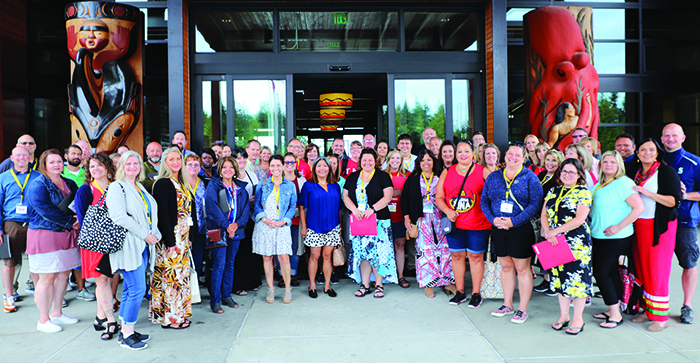
“Did you know that over 60% of our tribe of nearly 5,000 members is 18 or younger?” asked Patti Gobin, Natural Resources Special Projects Manager. “The importance of the good work going on right now is vital to our young ones because in the most literal sense, they are our future. We’ve been waiting a long time for you to accept, understand, and uplift our people in the area of education. There is a sense of urgency to have our MSD educators know our treaty and to know, that as Coast Salish people, we still live our lifeways out here.”
“As Indian people, we need to have an education to navigate this modern world and build a better future,” added Board of Director Glen Gobin. “Marysville public schools have an obligation to help educate our students. But to do that you need to understand who we are and the social structures we deal with on the reservation. It’s so important we find a way to work together and the only way to do that is to commit to knowing who each other are. There will be struggles, but there will be successes as well. The only way to get through this is to build upon the successes and learn from the struggles, together.”
A powerful exercise in understanding and learning from history was then led by Heritage High School teacher Ms. Ervanna Little Eagle and Quil Ceda Elementary teacher Ms. Gina Bluebird. The lesson was titled Tulalip Boarding School Experience. The goal was to examine how colonized education affected generations of Tulalip people.
Using heartfelt and gut-wrenching testimonials from those who were forced to attend boarding schools in the early 1900s, the group participated in several listening and writing activities.
“I considered what it would be like to lose my identity and it was unimaginable,” shared one MSD administrator.
“The underlying goal was to assimilate the Indians. Boarding school were then a means of committing cultural genocide carried out by the federal government,” stated another.
After taking a few moments to let the full weight of the boarding school era and its historical trauma that affects many of their young Native students today, the group moved quietly from the meeting space, still thoroughly in reflection, and back to the school busses. The assembly of MSD leadership then visited the Don Hatch Youth Center, Tulalip Long House, and Boys & Girls Club. At each stop they chatted with longtime employees and students who were out and about enjoying summer vacation.
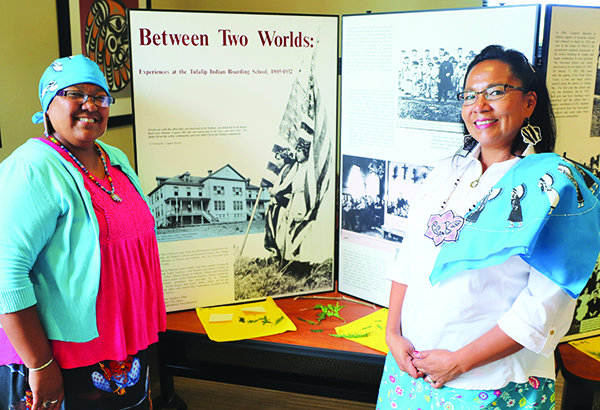
Finally, their journey came to its last destination on the reservation when they visited the present day site of the Tulalip Indian Boarding School. The group then formed a prayer circle led by Tulalip tribal member Monie Ordonia on those profane grounds in an effort to bring strength to power.
“For us to stand here is healing for our people because this is a very powerful circle,” said Chelsea. Her grandmother Celum Young attended the boarding school and once recalled being put in an outside jail cell for speaking just one word of her traditional language. “We have an opportunity to change our story in Marysville, not just for Native people. This isn’t just about our Native kids. This is about all of our kids. There are lots of historically underserved children in our district that we need to think differently about. We are growing and hopefully become stronger as leaders to make changes that benefit the entire district.”
There was a shared optimism after a full day designed to help MSD administrators and educators better understand their Tulalip students’ culture and community. Deeply rooted words like ‘healing’, ‘hopeful’, and ‘forgiveness’ were collectively expressed as the group reflected on their opportunities to become agents of change for the betterment of their diverse student population.
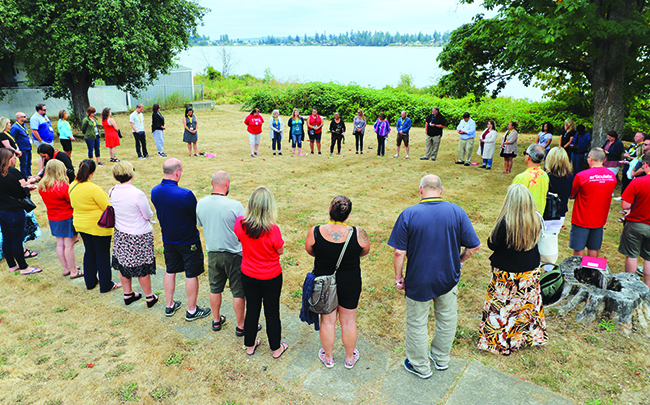
“It’s so important that we, as educators, make sure we are doing everything we can to help our Native American students become successful and reach their full potential,” said Eneille Nelson, Principal of Kellogg Marsh Elementary while taking in the Tulalip Bay view. “Being here to see where our students live and come from is very humbling. This space and land is so beautiful, and our students are just as beautiful as their surroundings.”“I didn’t know the history of the tribes and the painful experiences they’ve had with education,” admitted Tara Jeffries, Assistant Principal at Grove Elementary. She moved from Oregon last year to work for MSD. “It was so moving to have the opportunity to experience Tulalip culture in such an authentic way. This experience not only changed our perspective, but it changed our hearts. We now have a deeper understanding and can apply that in a way we couldn’t have before.”
With the 2019-2020 school year starting in a matter of weeks, only time and experience will determine how significant an impact the MSD/Tulalip cultural exchange has on new and returning students. But if all meaningful and lasting change starts on the inside, then a few changed hearts and minds can go a long way.
Please use the following link to download the August 17, 2019 issue of the syəcəb:
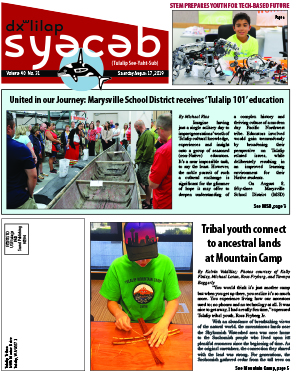
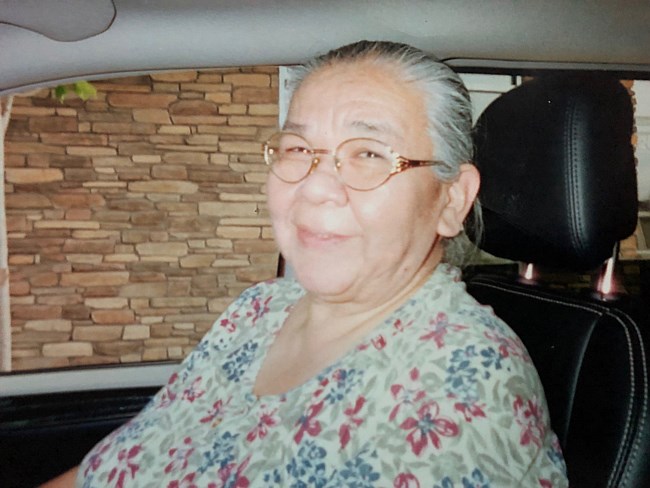
SEPTEMBER 14, 1949 – AUGUST 11, 2019
Jeannette Jean Williams, 69 of Tulalip, went to be with the Lord on August 11th 2019. Jeannette was born September 14th 1949 in Yakima, to Leo and LeValla Charles. As a young girl, she was always smiling and loved helping in any way she could, especially cooking. She met the love of her life, Henry, got married and shortly after moved to British Columbia, where she became a stepmother to his daughters. After Henry passed away in 1994, she moved back to Tulalip to care for her mother and be closer to her family. Jeannette was well known for her gift of crocheting and her love of playing bingo. Her favorite past time was just being around family, especially watching her Mariners and Seahawks games.
Jeannette is preceded in death by her husband Henry Williams; her parents Leo and LeValla Charles; brothers, Leo and Joseph; sister LeValla Charles; grandparents George and Madeline Johnny and Nora and Pete Dillon; stepdaughter Lita and numerous cousins and friends.
Jeannette is survived by her sisters, Rose Charles, Virginia Charles, Madeline Adams; brother George Charles; special nephews William Burchett Jr.(Katherine), Joseph Charles, special niece Rosemary Valencia(Roberto); very close great-nephew Desmond, and very close great-nieces Faith, Arielle, and Priscilla; close cousins Mildred, Vivian and Bobby and numerous friends and family.
Visitation will be held at Schaefer-Shipman Funeral Home on August 16th at 9:00 am. Services will begin at 10:00am. Burial to follow at Mission Beach Cemetery.
God gave us such a kind, loving, gentle, sweet, caring and patient lady, we were blessed to have her in our lives. If we can take something from her life to celebrate it, let it be these characteristics.
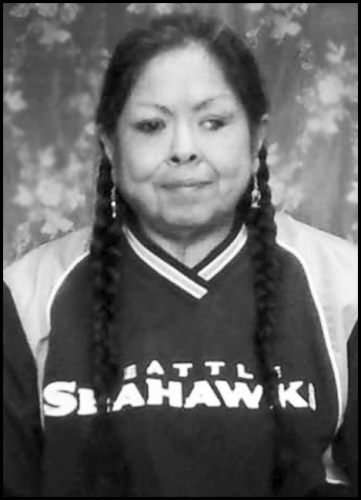
Alice Louise Henry Sept. 3, 1963 – August 8, 2019 Alice was born in Everett, WA, to John and Barbara Henry. Alice was the oldest daughter of six siblings. Alice was raised in Tulalip, WA, a fisherman’s daughter. She also loved riding her horse as a young girl. Alice also resided in Upper Skagit for a period of her life. Alice was a great daughter and sister dedicated to taking care of her family from a young age, which came to the decision of dropping out of school to work for Burger Mill to take care of her mom and little sisters. That didn’t stop her education – she continued her schooling, getting her GED and numerous certifications which later lead to her working for Upper Skagit as a Domestic Violence Advocate and Nurse’s Aide in an adult family living facility. Alice worked in Sauk-Suiattle for Northwest Intertribal. She also worked as a firefighter for the Upper Skagit County Forestry. She loved her job at Tulalip Nike Outlet and was dedicated to working as an office automation clerk, accounting technician, and reality specialty at the Bureau of Indian Affairs. Alice was a humble servant of God who loved praying and studying the word of God. Alice was a dedicated member of the Tulalip Worship Center and loved watching and listening to Jimmy Swaggart. Alice is preceded in death by her parents, John and Barbara Henry; sister, Louise; brothers, Adrian and Randy; and numerous aunts, uncles, and cousins. She is survived by her sisters, Kerri Henry and JLee Henry. Visitation will be Tuesday, August 13, 2019 at 1pm at Schaefer-Shipman Funeral Home. An evening service will be 6pm that same evening at the Tulalip Tribal Gym. Funeral service will be August 14, 2019 at 10am at the Tulalip Tribal Gym with burial to follow at Mission Beach Cemetery.
